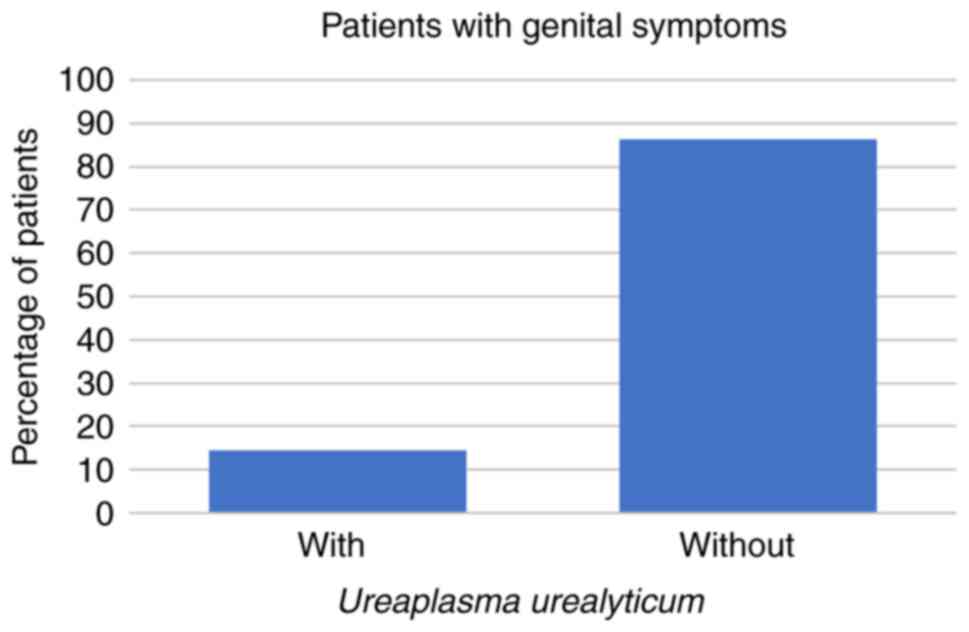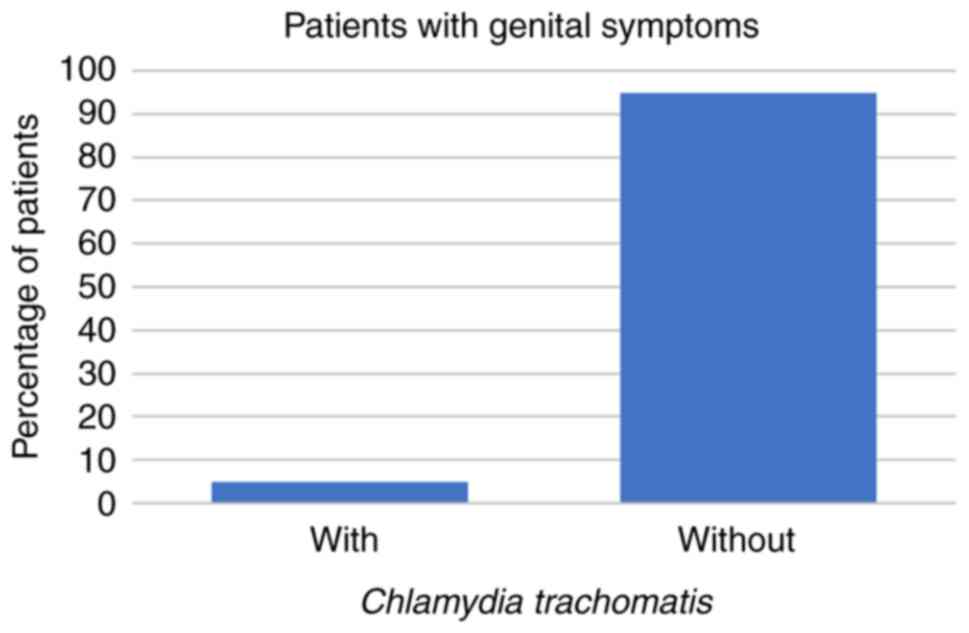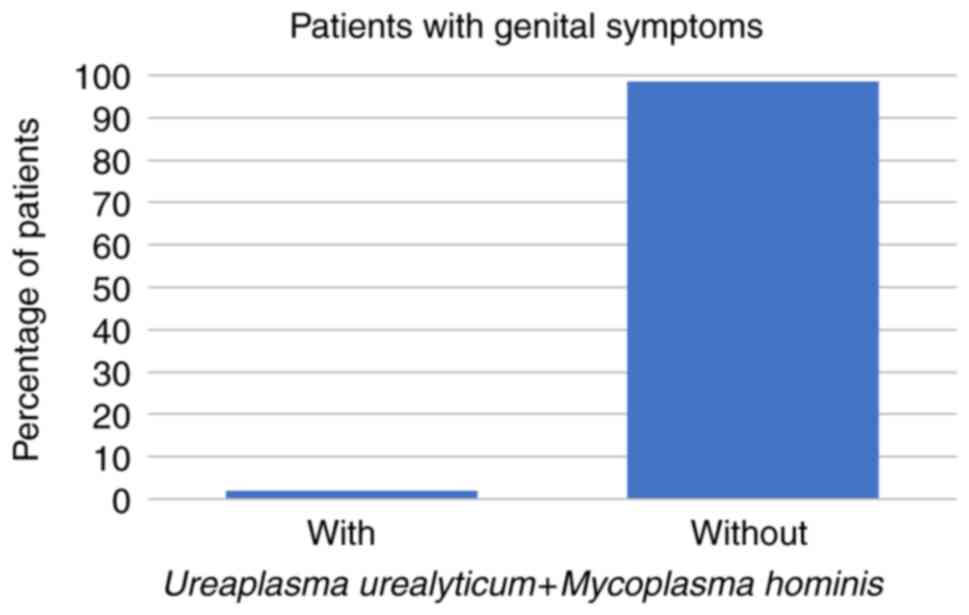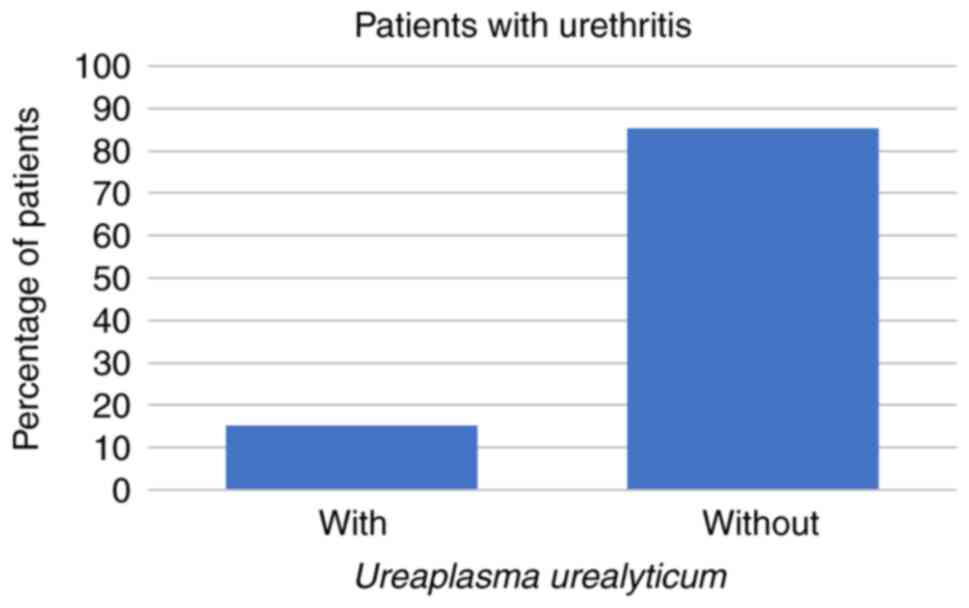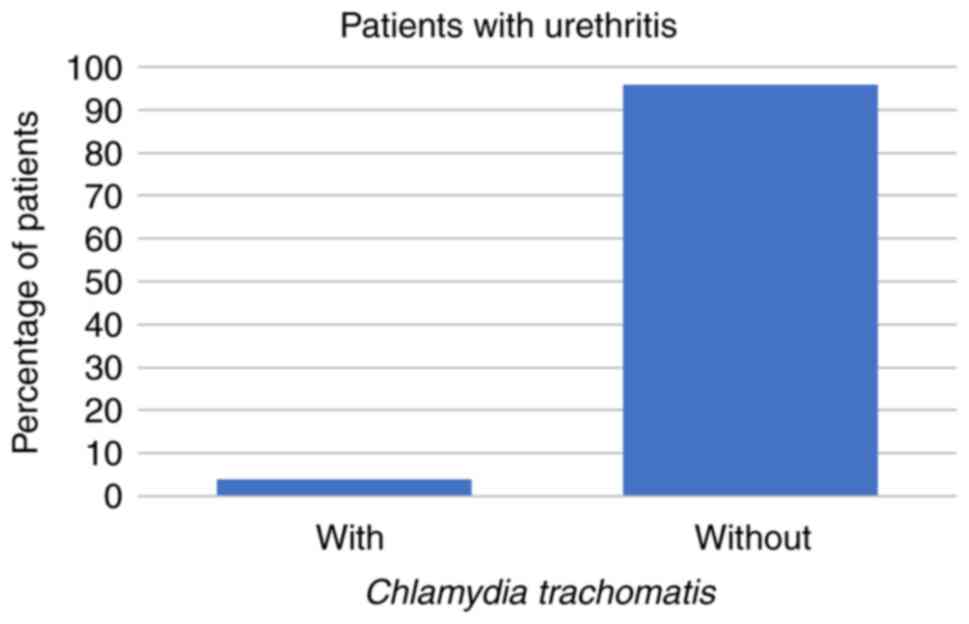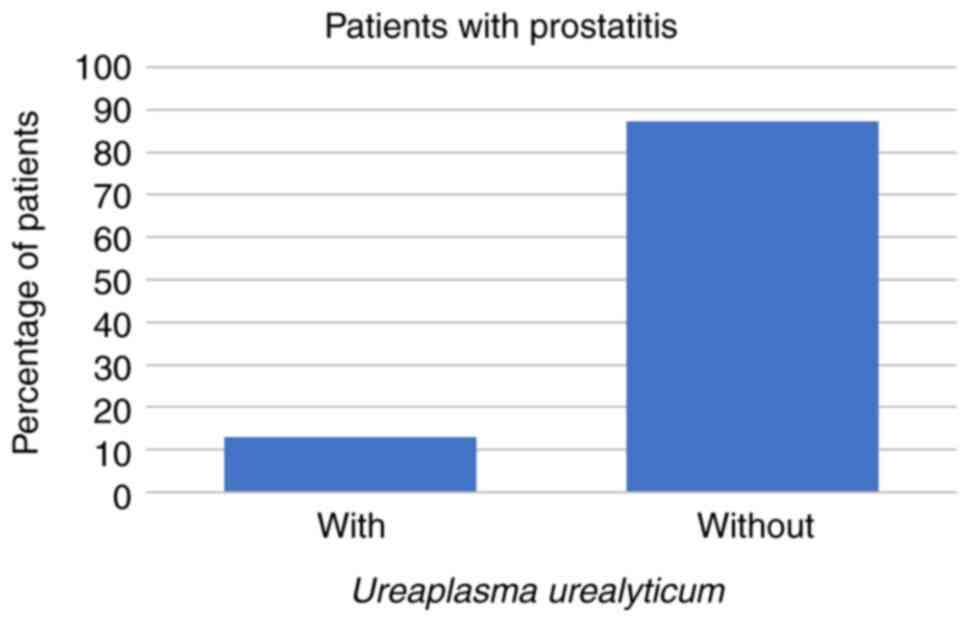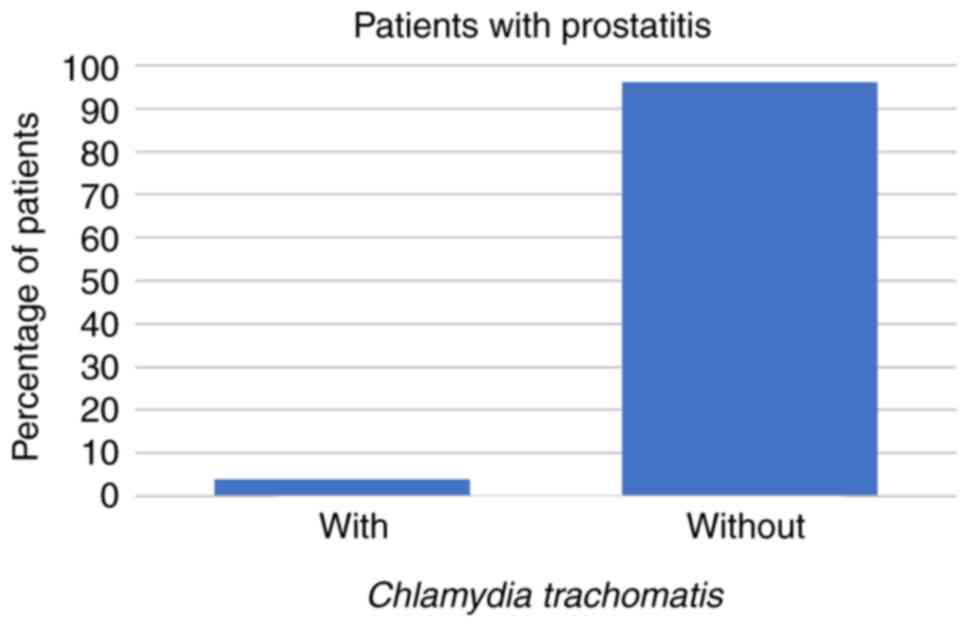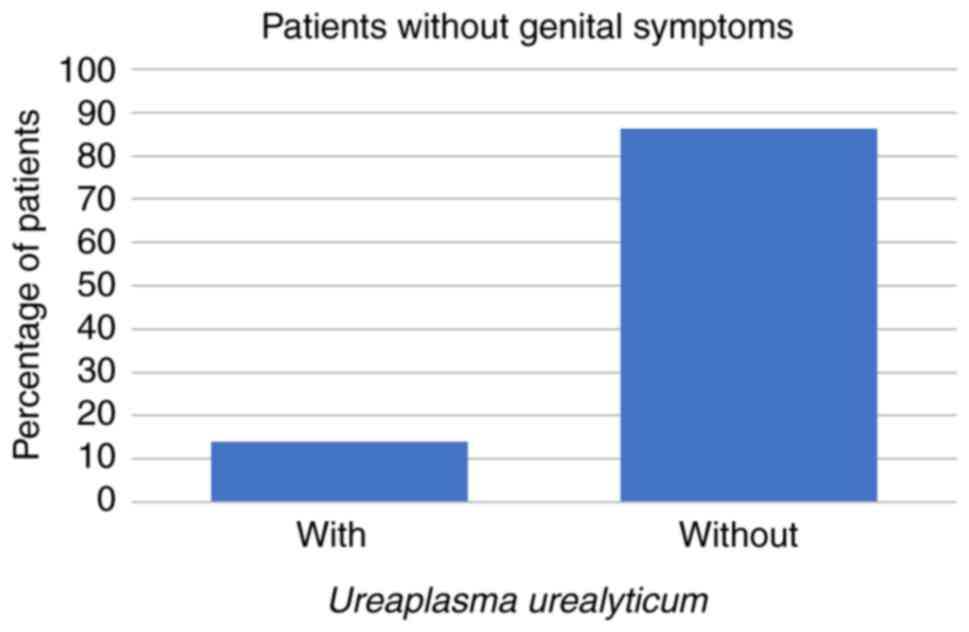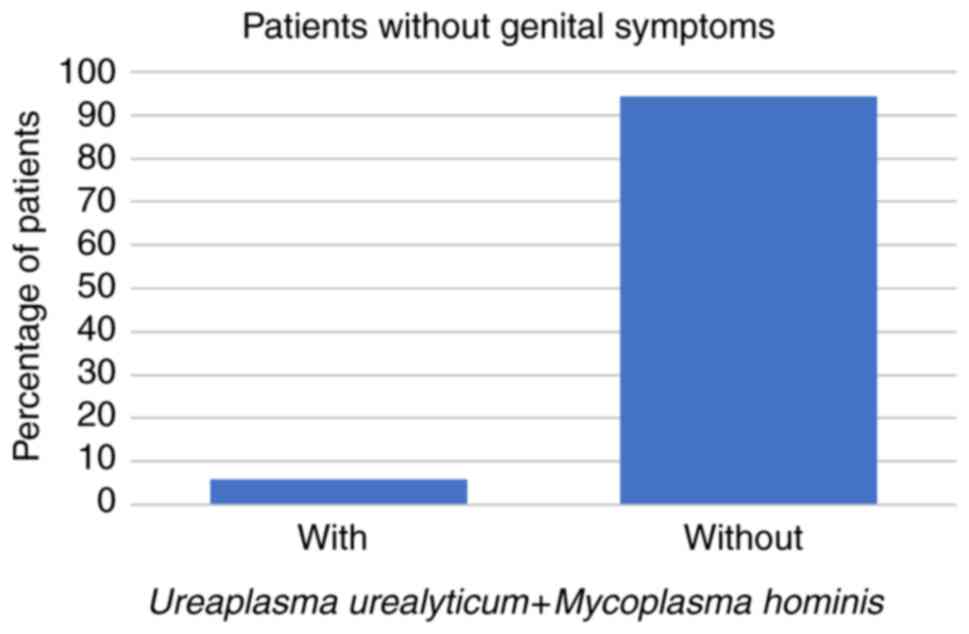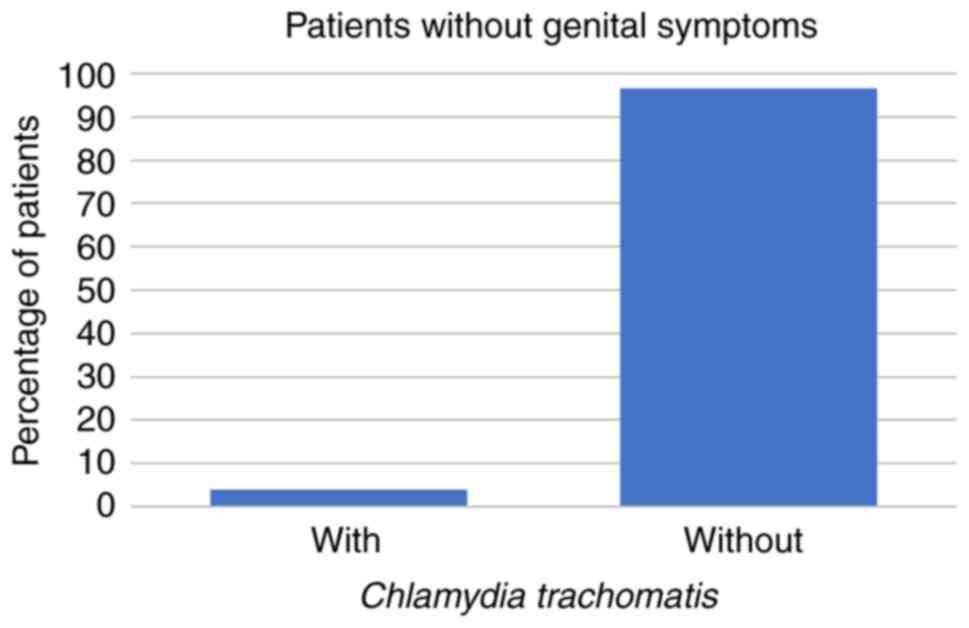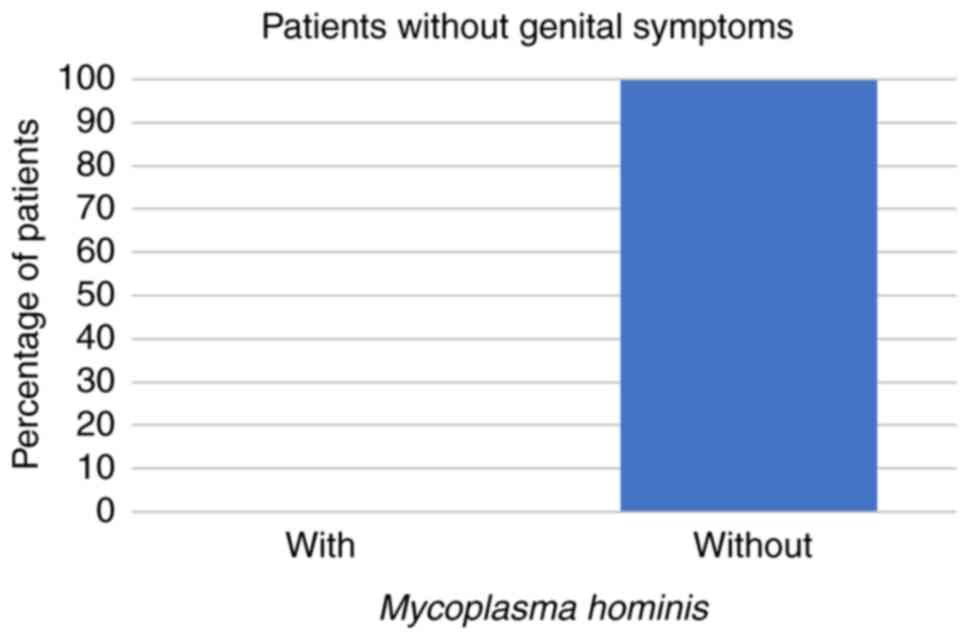Prevalence of Ureaplasma urealyticum, Mycoplasma hominis and Chlamydia trachomatis in symptomatic and asymptomatic patients
- Authors:
- Published online on: September 1, 2023 https://doi.org/10.3892/br.2023.1656
- Article Number: 74
-
Copyright: © Cutoiu et al. This is an open access article distributed under the terms of Creative Commons Attribution License.
Abstract
Introduction
Sexually transmitted diseases (STDs) occur worldwide and are an important public health problem. In developing countries, STDs rank among the five most frequent reasons for health services being sought (1). The term STDs refers to the various clinical symptoms generated by pathogenic microorganisms that are transmitted through sexual intercourse. Among the causative agents of STDs, Chlamydia trachomatis (C. trachomatis) is associated particularly with urethritis and cervicitis. Mycoplasma hominis (M. hominis) and Ureaplasma species are frequently found in the commensal microorganisms of the lower genital tract; however, their role in other sexually transmitted infections remains unclear. Ureaplasma urealyticum (U. urealyticum) was originally considered to have two biovars, biovar 1 and biovar 2, which were subsequently found to be separate species by polymerase chain reaction (PCR) and named U. parvum and U. urealyticum, respectively (2). Ureaplasma species are the most widely investigated pathogens associated with non-gonococcal urethritis, and the results are conflicting (3). U. urealyticum has been reported to cause infections in the lower genital tract, being a pathogen of male urethritis and a likely cause of bacterial vaginosis (2,3). Ureaplasma species, M. hominis and C. trachomatis can cause infertility in both men and women (4).
Mollicutes (U. urealyticum and M. hominis) and Chlamydia, when localized and colonized within certain anatomical sites, may cause pathological disorders, including urethritis in males and females, prostatitis and epididymitis in males, and vaginitis, endometriosis and salpingitis in females. Urethritis and vaginitis are characterized by discharge and/or dysuria, although they may also be entirely asymptomatic (5). C. trachomatis is the most common cause of non-gonococcal urethritis, with a prevalence in the general population of between 1 and 10% (6). The prevalence of Ureaplasma species and M. hominis has been reported to be 21 and 3%, respectively (7). These microorganisms can also cause sexually transmitted reactive arthritis (Reiter's Syndrome) (8). Regarding female patients, it is worthy of note that their role in the etiology of pregnancy complications has been suggested, including the induction of preterm labor, infertility, spontaneous abortion, puerperal fever and pelvic inflammatory disease (5,8). Moreover, the transmission of U. urealyticum to the fetus or newborn may cause severe bronchopulmonary dysplasia and central nervous system (CNS) infections (5).
The objective of the present study was to estimate the prevalence of U. urealyticum, M. hominis and C. trachomatis in a Romanian population taking into consideration the presence or absence of genital symptoms.
Materials and methods
Patients
The present study is a retrospective, observational study, conducted from January 2021 to December 2021. The study was conducted at ‘Ponderas’ Academic Hospital (Bucharest, Romania) in the Dermato-venerology Department. Data on all 266 patients who provided urogenital samples for Ureaplasma and Mycoplasma detection by culture were collected and analyzed, as well as urogenital samples for Chlamydia detection by PCR. Specimens were obtained from two different groups of patients: Symptomatic subjects who reported urogenital symptoms and were categorized in four subgroups, namely urethritis, prostatitis, vaginitis, and urethritis with prostatitis; and completely asymptomatic subjects who came for microbiological screening for STDs, a number of whom reported sexual contact with infected individuals. All patients were sexually active. Only samples collected during the first visit were considered in the study, and specimens obtained during follow-ups of the same patient were excluded. All procedures performed in the study were in accordance with the ethical standards of the institutional and/or national research committee and with the 1964 Declaration of Helsinki and its later amendments or comparable ethical standards. Written informed consent was obtained from all individual participants included in the study.
Urethral/vaginal swabs
Male patients were placed in the gynecological position and asked to retract the foreskin of the penis and keep it retracted throughout the procedure. The doctor used sterile cotton or gauze to clean the opening of the urethra at the tip of the penis. To facilitate sample collection and stimulate prostatic gland secretion, prostatic massage was performed prior to collection of the sample. Then, a first cotton swab was gently inserted ~2 cm into the urethra and rotated. To obtain a good sample, the test was performed ≥3 days from the last sexual intercourse and 2 h after urination. The swabs were placed in R1 broth from a Mycoplasma IST 2 kit (bioMérieux) to initiate the isolation of mycoplasmas. For female patients, the vaginal sample was taken by placing the patient in a gynecological position and carefully introducing a cotton swab into the vaginal canal. The use of commercial lubricants or antiseptics was avoided. The swabs were placed in R1 broth to initiate the isolation of Mollicutes. The liquid medium for U. urealyticum and M. hominis was a transport medium used for inoculation of a test strip. In order to perform the phenotypic identification of U. urealyticum, urea broth was used, which contained medium base (pleuropneumonia-like organism broth), yeast extract, horse serum and urea. To determine the growth of this microorganism, phenol red was added to the culture medium, as it changes from red to intense raspberry red in the presence of urease and ammonium production. The culture medium specific for M. hominis included arginine which, when metabolized, produces an alkaline compound that changes phenol red to a raspberry red color. The culture media were incubated at 37˚C until the phenol red indicator changed color. The Mycoplasma IST 2 kit was used according to the manufacturer's instructions as follows. As aforementioned, the sample-bearing swab was placed in the transport medium R1 broth (3 ml). The broth was mixed with the contents of the lyophilised R2 vial provided with the kit, which contained the substrates necessary for the development of microorganisms. A volume of 55 ml was added to each of the 22 domes in the test strip. Firstly, the phenotypic detection of M. hominis and U. urealyticum was performed. Secondly, the microorganisms were quantified, to determine whether the sample concentration was >1x104 change color-changing units (CCU), as this indicated an important presence of these microorganisms (positive result) (9).
A second swab was inserted in the urethra of male patients and the vaginal canal of women to collect urogenital samples for the detection of C. trachomatis by PCR. The samples were collected using a DNA collection device, comprising a cytobrush and DNA holder buffer (Specimen Transport Medium; Digene; Qiagen, Inc.), for the investigation of bacterial infections. Bacterial DNA samples were extracted from samples collected from the urogenital tract using an RTP®-Bacteria DNA kit (Invitek Diagnostics), according to the manufacturer's procedures and amplified using a 5TD6 ACE Detection kit (Allplex STI Essential Assay; Seegene, Inc.) for the detection of C. trachomatis by PCR. The PCR primer sequences are not disclosed by the manufacturer. The PCR conditions were as follows: 1 cycle of 94˚C for 15 min, 40 cycles of 94˚C for 30 sec, 63˚C for 90 sec and 72˚C for 90 sec, and 1 cycle of 72˚C for 10 min. The amplification of plasmidial DNA as an internal control occurred in the same reaction. The PCR product was subjected to electrophoresis on a gel containing 2% agarose stained with ethidium bromide. Amplification of the target was only observed when the respective bacterial DNA was present in the clinical sample (10). This method was applied to 30 samples. For the remaining 236 the testing method was changed due to financial issues at the laboratory. Images of the agarose gel are not available.
The subsequent method used for the detection of C. trachomatis involved the insertion of a swab in the urethra for male patients and the vaginal canal for women to collect urogenital samples for analysis by an alternative PCR method. The urethral sample was transferred into an Aptima Swab Specimen Transfer Tube (Hologic, Inc.). The samples were transported at a temperature of between 2 and 30˚C. Determination of C. trachomatis rRNA in the genital secretions was performed using the Panther® System analyzer (Hologic, Inc.), which is based on nucleic acid amplification testing with transcription-mediated amplification (TMA) and dual kinetic detection. TMA is an isothermal amplification method that uses RNA polymerase and reverse transcriptase. Since the amplification temperature is 37-42˚C, the technique does not require a thermocycler and can be performed using a thermoblock. TMA uses two primers that flank the region to be amplified: A promoter primer and a non-promoter primer with the same sense as the target. The 3' end of the promoter primer is complementary to that of the target RNA and the 5' end is recognized by RNA polymerase. Amplification is initiated via the binding of the promoter primer to the target RNA, which is then reverse transcribed to generate cDNA. The DNA-RNA duplex is degraded, and the RNA released through the RNase H activity of the reverse transcriptase. The second primer binds to the cDNA and generates double-stranded molecules. Hundreds of copies of the RNA amplicons are thus transcribed by means of this DNA and each copy can be converted into new double-stranded DNA molecules. The amplification products are analyzed by hybridization with oligonucleotide probes labeled with chemiluminescent substances. Assay results were automatically interpreted by APTIMA Assay software (Panther System®; Hologic, Inc.) using the APTIMA Combo 2 protocol, and presented as individual CT test results. Based on the kinetic type and total relative light units (RLU) in the detection step, the test results were assigned as negative (RLU <25), equivocal (RLU <100), positive (RLU >100) or invalid (11).
Statistical analysis
Categorical variables are expressed as counts and percentages. Tests of association were performed using Chi-square or Fisher's exact tests, as appropriate. P<0.05 was considered to indicate a statistically significant result, at which the null hypothesis could be rejected. Data were analyzed with R Statistical Software version 4.1.1 (https://www.r-project.org).
Results
The study population consisted of 266 patients (225 males and 41 females) aged between 18 and 80 years, and 89% of the patients were aged 31-50 years. Among these 266 patients, 59 (22%) had STD symptoms while the other 207 patients (78%) had no STD symptoms at all. Regarding the symptomatic patients, 8 (14%) had U. urealyticum, 1 (2%) had U. urealyticum and M. hominis coinfection, 3 (5%) had C. trachomatis, and no symptomatic patients were infected with M. hominis alone (all P<0.001; Fig. 1, Fig. 2 and Fig. 3; Table I).
Symptoms of urethritis were reported by 27/266 (10%) of the patients. Of those 27 patients, 4 (15%) had U. urealyticum and 1 (4%) had C. trachomatis, but none of the patients with symptoms of urethritis had U. urealyticum and M. hominis coinfection or were infected with M. hominis alone (all P<0.001; Figs. 4 and 5; Table II).
In the present study, 23/266 (9%) patients presented symptoms characteristic of prostatitis. These comprised 3 patients (13%) whose prostatitis was caused by U. urealyticum and 1 (4%) in which the prostatitis was caused by C. trachomatis, while prostatitis was caused neither by U. urealyticum and M. hominis coinfection, nor by M. hominis alone in these patients (all P<0.001; Figs. 6 and 7; Table II).
Symptoms of both urethritis and prostatitis were present in 6/266 (2%) of the patients. Only 1/6 patients with these symptoms (17%) was infected with C. trachomatis (P=0.1025; Table II). Neither of the Mollicutes was detected in patients with urethritis and prostatitis (P=0.003892).
The study population included 207/266 (78%) patients who were completely asymptomatic. Among these 207 patients, 29 (14%) were discovered to have U. urealyticum, 13 (6%) were coinfected with both Mollicutes, 1 (0%) was infected with M. hominis alone and 4 (2%) were infected with C. trachomatis (all P<0.001; Fig. 8, Fig. 9, Fig. 10 and Fig. 11; Tables I and II).
Regarding the female patients, there were only 3 cases of vaginitis, one of which was a symptomatic coinfection with Mollicutes. The remaining 38 women had asymptomatic genital infections.
The association between the Mollicutes and C. trachomatis was also evaluated. It was found that 2 patients (14%) with U. urealyticum and M. hominis coinfection were also infected with C. trachomatis, while none of the patients who were infected with U. Urealyticum or M. hominis alone were also positive for C. trachomatis (P=0.1071).
Discussion
The genital tract is a propitious area for the growth of numerous microorganisms, some of which may cause pathologies, including urethritis, endometriosis, epididymitis and salpingitis. Urethritis is characterized by discharge and/or dysuria, although it can also occur without any symptoms. Urethritis may be either gonococcal, when Neisseria gonorrhoeae is detected, or non-gonococcal (5). M. hominis and U. urealyticum are commonly found in the genitourinary tract as causative agents for several STDs. In men, U. urealyticum is a major cause of non-gonococcal urethritis, which may also be caused by M. hominis to a lesser extent (12). These microorganisms can cause sexually transmitted reactive arthritis (Reiter's syndrome), epididymitis and chronic prostatitis, and are suggested to play a role in pregnancy complications. In addition, U. urealyticum transmission to the fetus may cause bronchopulmonary dysplasia and CNS infections (5).
Although previous studies showed a greater prevalence of the Mollicutes and/or Chlamydia in women (13,14), mainly male patients are seen in the Dermato-venerology Department at ‘Ponderas’ Academic Hospital as women are usually referred to the Gynecology Department. Therefore, 225 of the 266 patients enrolled in the study were male. Similar to other studies (15,16), 207/266 (78%) were completely asymptomatic. This emphasizes the requirement for STD screening in sexually active individuals, since many modern STDs can be clinically silent, while their outcomes could be serious.
The most common symptom in all male patients was urethritis (10%), the main causes of which were U. urealyticum (15%) and C. trachomatis (4%). In addition, 9% of the male patients had symptoms suggestive of prostatitis. Similar to urethritis, the causative agents of prostatitis were found to be U. urealyticum (13%) and C. trachomatis (4%). Both urethritis and prostatitis were present in 6 (2%) of the male patients, which was caused by C. trachomatis in 1 case. Regarding the asymptomatic patients, the main infective agent detected in the present study was U. urealyticum (14%), followed by coinfection (6%), C. trachomatis (2%), and M. hominis in a single patient (0%), which is similar to the pattern of infection in symptomatic patients: 14% U. urealyticum, 5% C. trachomatis and 2% coinfection. The small proportion of cases with M. hominis, only one asymptomatic male, may be attributed to the small number of women included, although it is consistent with literature data (17).
Recent studies have shown that the prevalence of Ureaplasma species and M. hominis is ~21 and 3%, respectively (7) and the prevalence of C. trachomatis is ~2.9% (18). In the present study, the percentages are consistent with the worldwide trend regarding Mollicutes, but differ slightly regarding infection with C. trachomatis, with a prevalence of 2% for asymptomatic patients and 5% for individuals who presented with genital symptoms. A similar percentage to that in the present study has been identified in Latin America and regions of Africa, at 6.7 and 3.8%, respectively (18). Regional variations may be associated with social, cultural and economic conditions, differences in control policy and gender inequality, but those require examination in further studies (18). Moreover, it should be taken into account that, generally, women are more affected by these infections than men. Since the individuals enrolled in the present study were predominantly males, further studies are required in order to obtain an accurate percentage. In the future, statistics from the Dermato-venerology Department will be compared from those in the Gynecology Department to determine if there is an important difference regarding infection with Mollicutes and C. trachomatis between the sexes in Romania. However, many gynecologists in Romania do not include testing for Mollicutes and C. trachomatis in the basic screening process, unless the patients report urogenital symptoms. A study from Spain illustrated that the prevalence of U. urealyticum was 17.73%, and the prevalence of M. hominis and C. trachomatis was 10.64 and 26.95%, respectively, in men with and without symptoms of urethritis (19). In addition, studies of Chinese patients indicated that the overall prevalence of total Ureaplasma species and/or M. hominis was 38.1% from 2013 to 2019. Ureaplasma species were the most frequently isolated (overall prevalence, 31.3%), followed by Ureaplasma species/M. hominis coinfection (6.0%) and single M. hominis infection (0.8%) (20,21).
These marked differences between countries and regions could be due to the lack of sexual education in young individuals in developing countries, insufficient screening tests or poor technique during sample collecting. In addition, numerous physicians do not routinely perform tests for Mollicutes and/or C. trachomatis.
Notably, it is recommended that sampling should be performed by the physician, not a nurse, since the nurse may not have undergone adequate training in the collection of urethral swabs, resulting in false negative results. In the Dermato-venerology Department of ‘Ponderas’ Academic Hospital, the dermatovenerologists perform these maneuvers to enhance the validity of the tests. Moreover, urethral swabs are collected from male patients to search for C. trachomatis, instead of urine samples. This is because it is more convenient to collect all samples at once when performing a complete STD screen. However, this procedure is more uncomfortable for the patient.
Finally, it must be emphasised that Ureaplasma and Mycoplasma are opportunistic pathogens, frequently found in the commensal flora of the lower genital tract. The Mycoplasma kit used in the present study determined whether the sample concentration was >1x104 CCU in order to make a diagnosis of Mollicute infection. However, previously reported studies describe different techniques for Mollicute and Chlamydia detection. Some of these evaluated the microscopy of Gram-stained urethral smears in the diagnosis of non-gonococcal urethritis, and reported a threshold of ≥2 polymorphonuclear leukocytes/high power field as being indicative of a positive result (22-24). A comparison of the two diagnostic methods will be made in a future study.
In conclusion, the most prevalent pathogen populating the genital tract in both males and females is U. urealyticum, followed by U. urealyticum and M. hominis coinfection, and C. trachomatis. Numerous infections are asymptomatic, but should be screened for, since they can cause serious complications, most importantly infertility in men and women. Furthermore, the present study raises awareness of the importance of complete STD screening, regardless of the presence of symptoms.
Acknowledgements
Not applicable.
Funding
Funding: No funding was received.
Availability of data and materials
All data generated or analyzed during this study are included in this published article.
Authors' contributions
AC performed the statistical analysis, critically reviewed literature findings and revised the manuscript. DB collected the urethral and vaginal swabs from the patients and sent them to the laboratory, and conceived and designed the study. AC and DB confirm the authenticity of all the raw data. All authors read and approved the final version of the manuscript.
Ethics approval and consent to participate
The study was approved by the Ethics Committee of ‘Ponderas’ Academic Hospital (approval no. 509/16.02.2022). Written informed consent was obtained from all patients prior to publication.
Patient consent for publication
Not applicable.
Competing interests
The authors declare that they have no competing interests.
References
|
Campos GB, Lobão TN, Selis NN, Amorim AT, Martins HB, Barbosa MS, Oliveira TH, dos Santos DB, Figueiredo TB, Miranda Marques L and Timenetsky J: Prevalence of Mycoplasma genitalium and Mycoplasma hominis in urogenital tract of Brazilian women. BMC Infect Dis. 15(60)2015.PubMed/NCBI View Article : Google Scholar | |
|
Choe HS, Lee DS, Lee SJ, Hong SH, Park DC, Lee MK, Kim TH and Cho YH: Performance of AbyplexsTM II multiplex real-time PCR for the diagnosis of seven sexually transmitted infections: Comparison with currently available methods. Int J Infect Dis. 17:e1134–e1140. 2013.PubMed/NCBI View Article : Google Scholar | |
|
Wetmore CM, Manhart LE, Lowens MS, Golden MR, Whittington WL, Xet-Mull AM, Astete SG, McFarland NL, McDougal SJ and Totten PA: Demographic, behavioral, and clinical characteristics of men with nongonococcal urethritis differ by etiology: A case-comparison study. Sex Transm Dis. 38:180–186. 2011.PubMed/NCBI View Article : Google Scholar | |
|
Esen B, Gozalan A, Sevindi DF, Demirbas A, Onde U, Erkayran U, Karakoc AE, Hasçiçek AM, Ergün Y and Adiloglu AK: Ureaplasma urealyticum: Presence among Sexually transmitted diseases. Jpn J Infect Dis. 70:75–79. 2017.PubMed/NCBI View Article : Google Scholar | |
|
Salari MH and Karimi A: Prevalence of Ureaplasma urealyticum and Mycoplasma genitalium in men with non-gonococcal urethritis. East Mediterr Health J. 9:291–295. 2003.PubMed/NCBI | |
|
Dielissen PW, Teunissen DA and Lagro-Janssen AL: Chlamydia prevalence in the general population: Is there a sex difference? a systematic review. BMC Infect Dis. 13(534)2013.PubMed/NCBI View Article : Google Scholar | |
|
Lee JY and Yang JS: Prevalence and antimicrobial susceptibility of mycoplasma hominis and ureaplasma species in nonpregnant female patients in South Korea indicate an increasing trend of pristinamycin-resistant isolates. Antimicrob Agents Chemother. 64:e01065–20. 2020.PubMed/NCBI View Article : Google Scholar | |
|
Cutoiu A and Boda D: Antimicrobial Resistance of Ureaplasma Urealyticum and Mycoplasma Hominis in the Romanian population. Farmacia. 71(1)2023. | |
|
D'Inzeo T, De Angelis G, Fiori B, Menchinelli G, Liotti FM, Morandotti GA, De Maio F, Nagel D, Antonaci M, Sanguinetti M and Spanu T: Comparison of Mycoplasma IES, Mycofast Revolution and Mycoplasma IST2 to detect genital mycoplasmas in clinical samples. J Infect Dev Ctries. 11:98–101. 2017.PubMed/NCBI View Article : Google Scholar | |
|
Christofolini DM, Leuzzi L, Mafra FA, Rodart I, Kayaki EA, Bianco B and Barbosa CP: Prevalence of cases of Mycoplasma hominis, Mycoplasma genitalium, Ureaplasma urealyticum and Chlamydia trachomatis in women with no gynecologic complaints. Reprod Med Biol. 11:201–215. 2012.PubMed/NCBI View Article : Google Scholar | |
|
Stary A, Schuh E, Kerschbaumer M, Gotz B and Lee H: Performance of transcription-mediated amplification and Ligase chain reaction assays for detection of chlamydial infection in urogenital samples obtained by invasive and noninvasive methods. J Clin Microbiol. 36:2666–2670. 1998.PubMed/NCBI View Article : Google Scholar | |
|
Cordova CM and Cunha RA: Relevant prevalence of Mycoplasma hominis and Ureaplasma urealyticum serogroups in HIV-1 infected men without urethritis symptoms. Rev Inst Med Trop Sao Paulo. 42:185–188. 2000.PubMed/NCBI View Article : Google Scholar | |
|
Foschi C, Salvo M, Galli S, Moroni A, Cevenini R and Marangoni A: Prevalence and antimicrobial resistance of genital Mollicutes in Italy over a two-year period. New Microbiol. 41:153–158. 2018.PubMed/NCBI | |
|
Moridi K, Hemmaty M, Azimian A, Fallah MH, Khaneghahi Abyaneh H and Ghazvini K: Epidemiology of genital infections caused by Mycoplasma hominis, M. genitalium and Ureaplasma urealyticum in Iran; a systematic review and meta-analysis study (2000-2019). BMC Public Health. 20(1020)2020.PubMed/NCBI View Article : Google Scholar | |
|
Moi H, Blee K and Horner PJ: Management of non-gonococcal urethritis. BMC Infect Dis. 15(294)2015.PubMed/NCBI View Article : Google Scholar | |
|
Park JJ, Seo YB, Jeong S and Lee J: Prevalence of and risk factors for sexually transmitted infections among Korean adolescents under probation. J Korean Med Sci. 32:1771–1778. 2017.PubMed/NCBI View Article : Google Scholar | |
|
Grad AI, Vica ML, Ungureanu L, Siserman CV, Tătaru AD and Matei HV: Assessment of STI screening in Romania using a multiplex PCR technique. J Infect Dev Ctries. 14:341–348. 2020.PubMed/NCBI View Article : Google Scholar | |
|
Huai P, Li F, Chu T, Liu D, Liu J and Zhang F: Prevalence of genital Chlamydia trachomatis infection in the general population: A meta-analysis. BMC Infect Dis. 20(589)2020.PubMed/NCBI View Article : Google Scholar | |
|
Foronda-García-Hidalgo C, Liébana-Martos C, Gutiérrez-Soto B, Expósito-Ruiz M, Navarro-Marí JM and Gutiérrez-Fernández J: Prevalence among males from the general population of agents responsible of not ulcerative genital tract infections, assisted in specialized care. Rev Esp Quimioter. 32:545–550. 2019.PubMed/NCBI(In Spanish). | |
|
Song J, Wu X, Kong Y, Jin H, Yang T, Xie X and Zhang J: Prevalence and antibiotics resistance of Ureaplasma species and Mycoplasma hominis in Hangzhou, China, from 2013 to 2019. Front Microbiol. 13(982429)2022.PubMed/NCBI View Article : Google Scholar | |
|
Zhu X, Li M, Cao H, Yang X and Zhang C: Epidemiology of Ureaplasma urealyticum and Mycoplasma hominis in the semen of male outpatients with reproductive disorders. Exp Ther Med. 12:1165–1170. 2016.PubMed/NCBI View Article : Google Scholar | |
|
Sarier M, Sepin N, Duman I, Demir M, Hizel A, Göktaş Ş, Emek M, Kukul E and Soylu A: Microscopy of Gram-stained urethral smear in the diagnosis of urethritis: Which threshold value should be selected? Andrologia. 50(e13143)2018.PubMed/NCBI View Article : Google Scholar | |
|
Sarier M, Sepin N, Emek M, Germen AT, Hoscan MB, Konuk E and Turgut H: Evaluating the utility of the A.F. Genital System test for pathogen diagnosis in acute male urethritis. Andrologia. 54(e14377)2022.PubMed/NCBI View Article : Google Scholar | |
|
Sarier M, Demir M, Turgut H, Hizel A, Emek M, Kukul E and Sepin N: New approach to microscopy of gram-stained urethral smear: The kissing slide method. Sex Transm Dis. 47:712–715. 2020.PubMed/NCBI View Article : Google Scholar |



